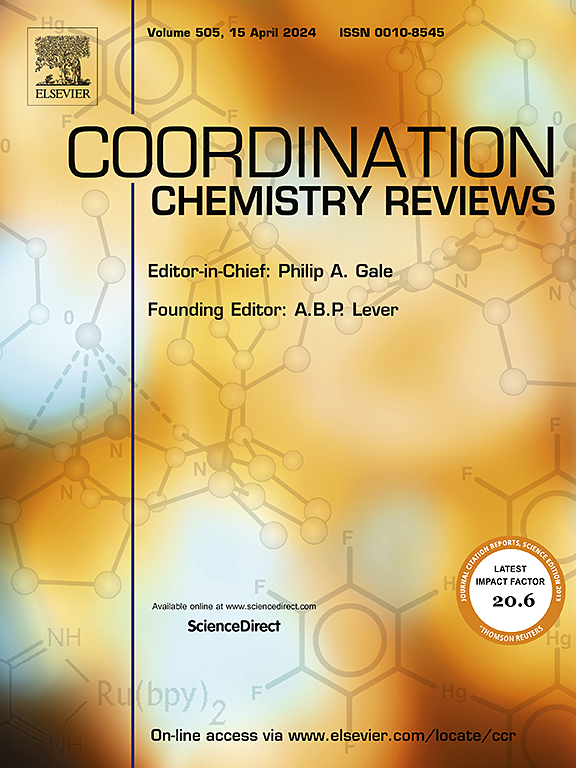微流控技术在金属有机骨架及其复合材料合成中的应用
IF 23.5
1区 化学
Q1 CHEMISTRY, INORGANIC & NUCLEAR
引用次数: 0
摘要
自20世纪90年代开始,微流控技术已经成为纳米材料合成的通用平台,在过去的十年中,微流控技术在金属有机框架(mof)的可控连续制造中表现出特别的功效。mof作为一类新型的高多孔晶体材料,通过金属团簇与有机连接剂的协调构建而成,由于其可调的结构和卓越的物理化学性质,已经引起了各个学科的极大关注。随着时间的推移,已经建立了各种合成方法来设计具有定制成分和晶体结构的mof。本文系统地综述了微流体辅助合成MOFs及其杂化复合材料的最新进展。在简要概述了用于纳米材料制造的微流控系统之后,我们批判性地分析了通过微流控平台合成MOF的最新策略,强调了它们在精确调节反应动力学、增强晶体均匀性和可扩展的高通量生产方面无与伦比的能力。此外,还介绍了集成微流控技术合成mof的其他先进技术的最新进展。重点分析了微流体工程和MOF结晶机制之间的协同相互作用,阐明了这种集成如何在扩展功能应用的同时使对成核生长动力学的基本见解成为可能。微流控技术与MOF合成的融合将加速框架组装的机理研究和多功能MOF系统的合理设计,从而为能源、催化和生物医学工程的突破性发展铺平道路。本文章由计算机程序翻译,如有差异,请以英文原文为准。


The application of microfluidic technologies in synthesis of metal-organic frameworks and their composites
Since its inception in the 1990s, microfluidic technology has emerged as a versatile platform for nanomaterial synthesis, demonstrating particular efficacy in the controlled continuous fabrication of metal-organic frameworks (MOFs) over the past decade. As a novel class of highly porous crystalline materials constructed through the coordination of metal clusters with organic linkers, MOFs have garnered significant attention across diverse disciplines owing to their tunable architectures and exceptional physicochemical properties. Over time, various synthetic methodologies have been established to engineer MOFs with tailored compositions and crystalline configurations. This review systematically examines recent progress in microfluidic-assisted synthesis of MOFs and their hybrid composites. Following a concise overview of microfluidic systems for nanomaterial fabrication, we critically analyze state-of-the-art strategies for MOF synthesis via microfluidic platforms, emphasizing their unparalleled capabilities in precise regulation of reaction kinetics, enhanced crystallographic uniformity, and scalable high-throughput production. Besides, recent developments of other advanced techniques that integrated into microfluidics for synthesis of MOFs are also examined. A focused analysis is presented on the synergistic interplay between microfluidic engineering and MOF crystallization mechanisms, elucidating how this integration enables fundamental insights into nucleation-growth dynamics while expanding functional applications. The convergence of microfluidic technologies with MOF synthesis is poised to accelerate both mechanistic investigations of framework assembly and the rational design of multifunctional MOF-based systems, thereby paving the way for groundbreaking developments in energy, catalysis, and biomedical engineering.
求助全文
通过发布文献求助,成功后即可免费获取论文全文。
去求助
来源期刊

Coordination Chemistry Reviews
化学-无机化学与核化学
CiteScore
34.30
自引率
5.30%
发文量
457
审稿时长
54 days
期刊介绍:
Coordination Chemistry Reviews offers rapid publication of review articles on current and significant topics in coordination chemistry, encompassing organometallic, supramolecular, theoretical, and bioinorganic chemistry. It also covers catalysis, materials chemistry, and metal-organic frameworks from a coordination chemistry perspective. Reviews summarize recent developments or discuss specific techniques, welcoming contributions from both established and emerging researchers.
The journal releases special issues on timely subjects, including those featuring contributions from specific regions or conferences. Occasional full-length book articles are also featured. Additionally, special volumes cover annual reviews of main group chemistry, transition metal group chemistry, and organometallic chemistry. These comprehensive reviews are vital resources for those engaged in coordination chemistry, further establishing Coordination Chemistry Reviews as a hub for insightful surveys in inorganic and physical inorganic chemistry.
 求助内容:
求助内容: 应助结果提醒方式:
应助结果提醒方式:


